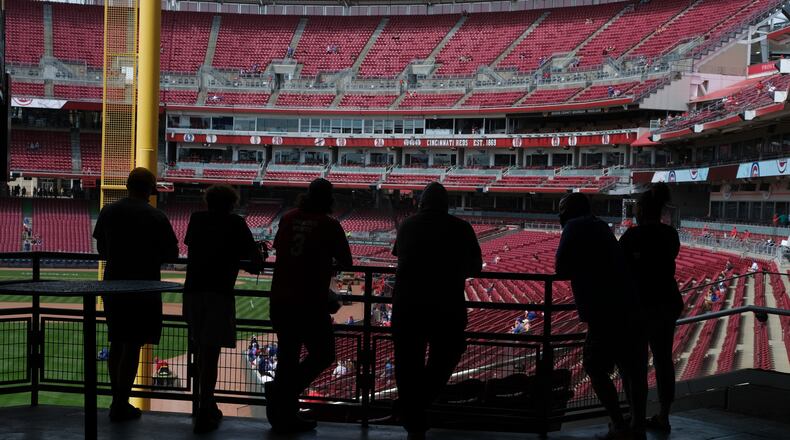What in the world?
I realize the Bengals basically lucked into Joe Burrow and that changes the whole picture, but they are coming off a season in which they overachieved all the way to the Super Bowl and have bright prospects for the future.
The Reds not only have underachieved for most of the last decade since blowing a 2-0 lead in the 2012 NLDS, their postseason series winless streak is nearly as long as the one the Bengals just snapped.
On balance, the Reds have somehow achieved less than the Bengals over the past two decades but still enjoyed a much better reputation off the field. Until now.
And with the recent sell-off streak (which may not be over), the Reds have little hope of winning soon, if ever.
Those last two words might seem a bit over-the-top, but what other conclusion is there to draw from the actions of the offseason?
The Reds had a winning record last year with a midde-of-the-pack payroll. Even with Nick Castellanos opting out of his contract, there was reason to feel good about 2022 because of the emergence of young talents Jonathan India and Tyler Stephenson last year plus the idea pitching prospects Hunter Greene and Nick Lodolo are close to big-league ready.
Despite how last season ended, I was surprisingly optimistic about the future in October.
Ownerships has squashed that emphatically in the months since by not only getting rid of multiple useful players but dumping relatively affordable ones for questionable (or zero) return.
One day after the Cincinnati Reds traded one of their best pitchers, Sonny Gray, they have dealt two of their best hitte... https://t.co/UbJEnzCQmZ
— Dayton Daily News (@daytondailynews) March 14, 2022
Standing pat and hoping for help from cheap and/or young sources is one thing, but stripping down the roster again is quite another.
The former is annoying and the latter is perplexing. The difference between some hope, however foolish, and none. That’s an especially big deal for a franchise that hasn’t sold anything but hope (and off-field promotions and history) very often since the turn of the century or longer.
If there is any justification for this austerity, let’s see it. Open the books and let people know exactly why operating on the cheap is so necessary. I understand the COVID-19 pandemic was tough on finances, but let’s see just how much cash the franchise has bled and why it can’t hope to recoup its losses while operating like a team that wants to win. Heck, if it’s really so bad maybe fans would actually take pity and want to help.
As of now, that seems to be the best hope of actually getting money from fans who are justifiably tired of watching the wheels spin in the riverfront mud and probably will have a hard time justifying paying for tickets or anything else from the team.
Hey, actually being broke would also provide some justification for the just-concluded lockout, which looked like petty actions taken by billionaires to avoid having to share any more of their billions of dollars from national TV (and other sources) than they have to because they prioritize that above fan or player happiness.
Of course some teams, including the Reds, are operating with significant shortfalls compared to others. Until now, I didn’t think “significant” meant “insurmountable,” but apparently they are.
And yet if that’s true, why was virtually no energy during this past labor stoppage devoted to actually fixing that problem?
The reality for teams in markets like Cincinnati, or so it has been assumed, is that building a winner isn’t that expensive but keeping one together is.
That means winning is possible even if sustaining it isn’t. That’s better than nothing, right?
Teams like the Rays and A’s have, seemingly by magic, managed to stay competitive over the years but perhaps the best example of this can be found to the northeast in our own state.
The Cleveland Indians (now Guardians) have built, torn down and rebuilt good teams by loading up for a run and knowing when to (however painfully) pull the plug to get started on the next one. Going back to the early 2000s, they have actually gotten good returns for their star players while the Reds rarely have.
Cleveland baseball has seen its share of valleys, but there have also been worthwhile peaks.
Meanwhile, the Reds have been atrocious at all of the things a small market team must do to compete: Drafting, developing and most of all maximizing their Major League assets. The latest string of deals is just the latest example. They have sold low on almost everyone since the 2010-12 team started going into decline, and few of their deals have even looked good when they were made let alone later.
So, yeah, I used to shake my head at those writers who said this Reds ownership group doesn’t want to win. I used to think they wanted do but didn’t know how. Now it is easiest to conclude it’s both.
The Dragons 22nd Opening Night game will be held Friday, April 8 when they host the Fort Wayne TinCaps at Day Air Ballpark at 7:05 p.m. https://t.co/f9fib9P64S
— Dayton Daily News (@daytondailynews) March 14, 2022
On the flip side, the Bengals seem to have kicked off free agency by filling needs with solid players at good values.
Hours into free agency, they added a pair of starter-quality offensive linemen without breaking the bank. There were splashier singings out there, but bringing in Ted Karras and Alex Cappa filled two needs while leaving more money to address more.
How they do that — whether via the draft, internally or via another free agent — should be interesting to watch.
Not like there is much else going on in Cincinnati sports these days.
About the Author

